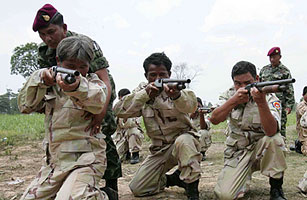
Cambodian and Thai troops squared-off for the fourth consecutive day on Monday, the latest in a series of deadly clashes over small but symbolically valued sections of territory along the Southeast Asian countries’ shared border. The flashpoints are two ancient temples known in Cambodia as Ta Krabey and Ta Moan, which lie 160 kilometers west of Preah Vihear, a cliff-top temple that is the focal point of the wider border dispute. At least twelve soldiers have been killed and dozens wounded since Friday. Thousands of civilians were evacuated over the weekend from their homes because of mortar and rocket fire, according to officials from both governments.
Each side has accused the other of initiating the new round of fighting, which has been waged mostly with long-range artillery fire. In written statements, Cambodia’s foreign ministry said Thai troops launched a “fierce armed offensive”, and Thailand’s foreign ministry alleged Cambodian troops prompted the flare-up with an “unprovoked attack.” The United Nations on Saturday urged both sides to exercise “maximum restraint” and agree upon an “effective and verifiable” ceasefire. The government of Indonesia, which currently holds the rotating chair for the Association of Southern East Asian Nations , the regional political bloc, called for an “immediate cessation to hostilities.” Improvised meetings scheduled for this evening between Indonesia’s foreign minister and his Cambodian and Thai counterparts were called off on Monday, suggesting a diplomatic resolution is not near.
For decades there have been disputes between Cambodia and Thailand over the demarcation of their 798-kilometer land border, and more recently over claims to maritime territory that is believed to hold deposits of oil and natural gas. The foundation of the current violent standoff was laid in 2008, when the picturesque Preah Vihear temple was given UN World Heritage status as a Cambodian site, over Thai objections. That decision followed a 1962 ruling by the International Court of Justice that granted ownership of the temple to Cambodia, whose people today are the descendants of the Khmer empire that constructed Preah Vihear as well as the two temples that are currently the scene of fighting. Critics in Thailand argue the temples fall within their country’s modern day borders.
The most recent clash follows fighting near Preah Vihear in early February in which eight people were killed. Civic groups confirm Cambodia’s claim that Thailand used cluster munitions during that episode. Cluster munitions scatter bomblets over vast areas and are considered especially dangerous to civilian populations; 108 countries have agreed to a UN ban on the weapons, though neither Thailand nor Cambodia is a signatory to the treaty. After the clashes in February, Cambodia requested unarmed Indonesian peacekeepers be posted along the border. Thailand’s foreign minister had agreed to that arrangement but the Thai military, which at times acts autonomously, balked at the deal.
Each side accuses the other of political maneuvering. In his weekly televised address on Sunday, Thai prime minister Abhisit Vejjajiva said Cambodia wished to escalate the conflict to attract international intervention: “Thailand will not fall into Cambodia’s trap in which the neighbor tries to intensify the conflict so violently that the dispute can no longer be solved at the bilateral level.” In a letter to the UN Security Council, Cambodian foreign minister Hor Namhong said Thailand’s insistence on limiting mediation to bilateral channels was “a pretext for using its larger and materially more sophisticated armed forces against Cambodia.” Thailand’s economy — $312.6 billion in GDP compared to $11.4 billion in Cambodia in 2010 — dwarfs its neighbor’s, and the disparity carries over to military spending: $2.9 billion by Thailand, compared to $191 million by Cambodia in 2009, the most recent year in which the Stockholm International Peace Research Institute has gathered statistics on both countries.
Analysts say the border spat has been complicated by domestic political divisions in Thailand. Since the telecom mogul-cum populist leader Thaksin Shinawatra was removed as prime minister in a military coup in 2006, the country has been bitterly split. The army’s role in that ouster and in the fatal suppression of protestors in Bangkok last year has polarized popular support for the military, which has long styled itself as the guardian of the state and monarchy. Thailand’s ruling party is expected to call an election as early as next month and speculation has swirled about the intentions of the Thai army, which fears a return to power of “Red Shirt” politicians affiliated with Thaksin.
“In any country where the army seeks a prominent role in politics, it needs a security dispute to command attention and influence,” says John Ciorciari, an assistant professor at University of Michigan’s Gerald R. Ford School of Public Policy. The Thai military is strongly wedded to the border dispute with Cambodia because their most loyal supporters, the “Yellow Shirt” activists, used the issue as a rallying cry to bring down prime minister Samak Sundaravej, a successor and ally of Thaksin, in 2008, alleging his stance against Cambodia was timid. “Now Abhisit is in the position of having to placate this constituency,” says Ciorciari.
The fighting and nationalistic groundswell emanating from the clashes have also helped Cambodian prime minister Hun Sen score political points by unifying the country against a common enemy, he added. Ultimately, however the perceived role of the Thai army in fueling ongoing tension, by intentionally refusing settlement options, for its own political gain has made Thailand’s position inferior to Cambodia’s in the eye of international observers, says Thitinan Pongsudhirak, a visiting professor at Johns Hopkins School of Advanced International Studies in Washington D.C. He says, “The court of international opinion is stacking up against Thailand.”
See TIME’s Pictures of the Week.
See the Cartoons of the Week.